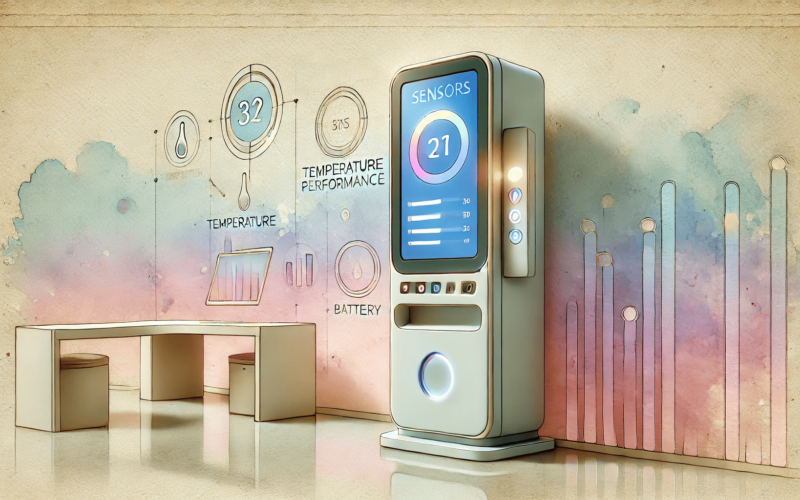Kiosks play a vital role in today’s business landscape, offering self-service options that are increasingly relied upon by customers across various sectors. As their popularity rises, so does the importance of ensuring that they are consistently operating at peak efficiency. Embedded sensors provide a practical solution for monitoring essential kiosk functions like temperature, screen health, and battery status. These sensors enable operators to receive real-time alerts, allowing for timely maintenance before any potential issues disrupt service. The integration of multi-format payment kiosks further enhances customer experience, offering a broader range of payment options, but brings new challenges in ensuring smooth functionality.
With the help of sensor technology, kiosk operators can effectively maintain equipment health and anticipate failures before they escalate into significant problems. Sensors can identify temperature fluctuations, which may signal overheating or other mechanical issues, prompting swift intervention. In a similar vein, battery sensors can keep track of charge levels and notify operators when the battery is running low or nearing the end of its lifespan. This proactive maintenance approach reduces the need for frequent repairs, minimizing downtime and lowering repair costs.
The need for these sensor systems is especially critical for businesses seeking to refine their maintenance strategies and minimize unexpected breakdowns. By gathering continuous data from sensors, operators can make informed decisions about when to carry out maintenance tasks or replace parts. These preventative measures not only extend the lifespan of kiosks but also improve customer satisfaction by minimizing instances of kiosk failure. With better performance, businesses can reduce the financial strain of constant maintenance, ensuring their systems stay reliable over time.
Benefits of temperature monitoring in kiosks
Maintaining the optimal temperature for kiosk equipment is a fundamental aspect of ensuring its longevity and performance. Overheating can cause a variety of issues, from screen malfunctions to internal component failures, making temperature monitoring crucial. Sensors embedded in kiosks can measure temperature fluctuations in real-time, sending alerts if the environment becomes too hot or too cold for optimal functioning. Temperature sensors are vital in preventing damage and ensuring the continuous operation of kiosks.
In environments where kiosks are exposed to direct sunlight or extreme weather conditions, temperature monitoring is even more critical. Such environmental factors can affect both hardware and software, leading to system crashes or degradation of display quality. By installing temperature sensors, operators can receive immediate notifications and take corrective action, such as activating cooling systems or adjusting kiosk settings. These proactive steps help avoid costly damage and ensure kiosks remain operational in all conditions.
Effective temperature monitoring also contributes to energy efficiency, another important factor in managing kiosk performance. With temperature sensors in place, operators can optimize the kiosk’s cooling and heating systems, reducing unnecessary energy consumption. This contributes to lower operational costs and supports sustainability efforts by minimizing the environmental impact of kiosk usage. These combined benefits demonstrate why temperature monitoring should be a top priority for kiosk operators.
Monitoring screen performance in kiosks
The performance of a kiosk’s screen is crucial for ensuring that users can interact with the system seamlessly and efficiently. A malfunctioning display can lead to a poor customer experience, potentially causing a loss of business and requiring costly repairs. To avoid these issues, it’s important to integrate sensors that can monitor the screen’s operational status and detect any anomalies. These sensors can track variables such as brightness, touch sensitivity, and overall functionality, sending alerts when the screen begins to experience problems.
When screen performance is actively monitored, operators can immediately respond to issues such as flickering, unresponsiveness, or display degradation. These real-time insights help technicians to pinpoint the cause of the problem quickly, whether it’s a hardware failure or a software glitch. Regular monitoring also assists in identifying gradual issues that could lead to complete screen failure, allowing for early interventions before a breakdown occurs. Proper sensor integration helps maintain high-quality user interactions and reduces the need for costly screen replacements.
For a more detailed approach to screen monitoring, consider a few key sensor-driven solutions. These include:
- Sensors that assess touch response to ensure users can interact with the screen without delay.
- Brightness sensors that adjust display settings based on environmental light levels.
- Sensors that detect pixel irregularities or color distortions, alerting operators to display quality issues.
With these monitoring strategies in place, kiosk operators can maintain high standards of screen performance and reduce customer complaints related to visual errors. This approach not only saves on repair costs but also ensures the kiosk remains fully functional for its users.
Monitoring battery health in kiosks
Kiosk operators rely on battery power to keep devices running smoothly, particularly in areas with intermittent power supply or in outdoor environments. Battery health monitoring plays a crucial role in extending the lifespan of kiosk systems and ensuring consistent performance. Through sensors that track charge levels, voltage, and overall battery condition, operators can receive real-time notifications when battery performance declines. This timely information allows for proper management of battery replacement schedules, avoiding service interruptions and reducing operational costs.
In addition to monitoring charge levels, certain sensors can also provide insights into the battery’s cycle life, indicating when a battery is nearing the end of its useful life. By continuously tracking the battery’s performance over time, operators can plan for replacements before unexpected failures occur. These sensor-based systems help maintain a seamless experience for customers, preventing sudden power losses that could impact kiosk availability. Battery health monitoring is an essential tool for maintaining reliable kiosk operations in any setting.
Improving maintenance efficiency with real-time data
The integration of sensors in kiosk systems offers a powerful advantage by providing real-time data on equipment performance. This data can significantly improve maintenance processes by allowing technicians to act proactively rather than reactively. By continuously monitoring various components, including temperature, screen performance, and battery health, operators can track the health of their equipment and make informed decisions. Such data-driven approaches not only extend the life of kiosks but also optimize operational efficiency by reducing downtime and minimizing emergency repairs.
Real-time data also enhances the accuracy of diagnostics, enabling technicians to address specific issues without wasting time on guesswork. This streamlined approach to maintenance not only reduces labor costs but also minimizes the risk of severe breakdowns that could disrupt business operations. Furthermore, with access to this valuable data, businesses can create long-term strategies for maintaining kiosk systems that are both cost-effective and customer-friendly. By relying on real-time data, businesses can ensure their kiosks operate at peak performance, delivering a consistent service experience.
Questions and answers
By integrating sensors, kiosk operators can continuously track crucial elements such as temperature, screen functionality, and battery health. This real-time monitoring allows for early identification of potential issues, facilitating proactive maintenance that minimizes both operational disruptions and repair costs.
Temperature sensors alert operators to potential overheating or environmental issues, ensuring optimal performance and preventing equipment failure. This helps extend the lifespan of kiosk components and minimizes maintenance expenses.
Battery monitoring ensures that kiosks remain operational without unexpected power loss, especially in remote areas or during power fluctuations. It allows operators to replace batteries before they fail, preventing service interruptions.

